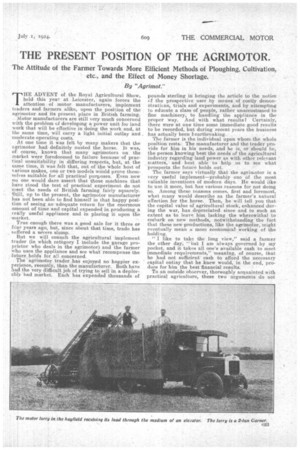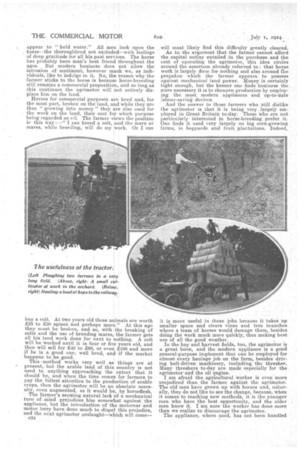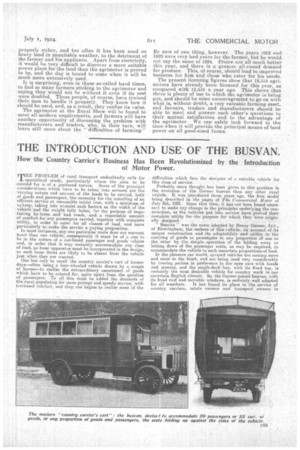THE PRESENT POSITION OF THE AGRIMOTOR.
Page 11

Page 12

Page 13

If you've noticed an error in this article please click here to report it so we can fix it.
The Attitude of the Farmer Towards More Efficient Methods of Ploughing, Cultivation, etc., and the Effect of Money Shortage.
By "Agrimot."
THE ADVENT of the Royal Agricultural Show, held this year at Leicester, again forces the attention of motor manufacturers, implement traders and farmers alike, upon the positionof the agrimotor and its present place in British farming.
Motor manufacturers are still very much concerned with the problem of developing a power unit for land work that will be effective in doing the work and, at the same time, will carry a light initial outlay and moderate operating costs,
At one time it was felt by many makers that the agrimotor had definitely ousted the horse. It was, of course, known that many agriniotora on the market were foredoomed to failure because of practical unsuitability in .differing respects, but, at. the same time, it was felt that, out of the 'whole host of various makes, one or two models would prove themselves suitable for all practical purposes. Even now no one would dare assert that those machines that have stood the test of practical experiment do not meet the needs of British farming fairly squarely. Still, up to the present, the agrimotor manufacturer has not been able to find himself in that happy position of seeing an adequate return for the enormous amount of time and capital expended in producing a really useful appliance and in placing it upon the market.
True enough there was a good sale for it three or fdur years ago, but, since about that time, trade has suffered a severe slump. But we will consult the agricultural implement trader (in which category I include the garage proprietor who deals in the agrimotor) and the farmer who uses the appliance and see what recompense the future holds for ail concerned.
.. The agrimotor trader has enjoyed no happier experience, recently, than the manufacturer. Both have had the very difficult job of trying to sell in a deplorably had rnaTket. Each has expended thousands of
pounds sterling in bringing the article to the notice ef the prospective user by means of costly demonstrations, trials and experiments, and by attempting to educate a class of people, rather unaccustomed to fine machinery, to handling the appliance in the proper way. And with what results? Certainly, there were at one time some immediate good results to be recorded, but during recent years the business has actually been heartbreaking. The farmer is the individual upon whom the whole position rests. The manufacturer and the trader pro. vide for him in his needs and he is, or should Vie, the .person knowing best the needs of the agricultural industry regarding land power as with other relevant matters, and best able to help us to see what prospects the future holds out. ,
The farmer says virtually that the agrimotor is a very useful implement—probably one of the most valuable inventions of modern days. He would iike to use it more, but has various reasons for not doing so. Among these reasons comes, first and foremost, what many would describe as the farmer's natural affection for the horse. Then, he will tell you that the capital value of agricultural stock, enhanced during the war, has depreciated since and to such an extent as to leave him lacking the wherewithal to embark on new methods, notwithstanding the fact that these new productions, like the agrimotor, might eventually mean a more economical working of the holding.
"I like to take the long view," said a farmer the other day, 'hut I am always governed by my pocket, and it takes all one's available cash to meet immediate requirements," meaning, of course, that he had not sufficient cash to afford the necessary capital outlay that he knew would, in the end, produce for him the best financial results.
To an outside observer, thoroughly acquainted with practical agriculture, these two arguments do not appear to "hold water." All men look upon the horse—the thoroughbred not ex2luded—with feelings of deep gratitude for all his past services. The horse has probably been man's best friend throughout the ages. But modern business does not allow the intrusion of sentiment, however much we, as inchyiduals, like to indulge in it. No, the reason why the farmer sticks to the horse is because horse-breeding still remains a commercial proposition, and so long as this continues the agrimotor will not entirely displace him on the land.
Horses for commercial purposes are bred and, for the most part, broken on the land, and while they are thus " growing into money " they are also used for the work on the land, their cost for which purpose being regarded as nil. The farmer views the position jr this way :—" I can breed a colt, and the mare or mares, while breeding, will do my work. Or I can buy a colt. At two years old these animals are worth 225 to £30 apiece and perhaps more." At this age they must be broken, and so, with the breaking of colts and the use of breeding mares, the farmer gets all his land work done for next to nothing. A colt will be worked until it is four or five years old, and then will sell for £40 to £60, or even £100 and more if he is a good one, well bred, and if the market happens to be good. This -method works very well as things are at present, but the arable land of this country is not used to anything approaching the extent that it should be, and when the time comes for farmers to pay the fullest attention to the production of arable crops, then the agrimotor will be an absolute necessity, even augmented, as it would be, by horseflesh.
The farmer's seeming natural lack of a mechanical turn of mind prejudices him somewhat against the appliance, hut the introduction of the motorcar and motor lorry have done much to dispel this prejudice, and the next agrimotor onslaught—which will come—
c24 will most likely find this difficulty greatly cleared.
As to the argument that the farmer cannot afford the capital outlay entailed in the purchase, and the cost of operating the agrimotor, this idea circles around the assertion already referred to : that horse work is largely done for nothing and also around fee prejudice which the farmer appears to possess against mechanical land power. Money is certainly tight enough, but the keener one finds business the more necessary it is to cheapen production by employing the most modern appliances and up-to-date labour-saving devices. And the answer to those farmers who still dislike the agrimotor is that it is being very largely emrayed in Great Britain to-day. Those who are not particularly interested in horse-breeding prefer it. One finds it used very largely on big corn-growing farms, in hopyards and fruit plantations. Indeed, it is more useful in these johs because it takes up smaller space and clears vines and tree branches where a team of horses would damage them, besides doing the work much more quickly, thus making best use of all the good weather. • In the hay and harvest fields, too, the agrimotor is a great boon, and the modern appliance is a good general-purpose implement that can be employed for almost every haulage job on the farm, besides driving, belt-driven machinery, including the thresher. Many threshers to-day are made especially for the agrimotor and the oil engine. I am afraid the agricultural worker is even more nrejudieed than the farmer against the agrimotor. The old men have grown up with horses and, niiturally, they do not like to see the change, because, when it comes to teaching new methods, it is the younger men who have the best opportunity, and the older men know it. I am sure the worker has done more than we realize to discourage the agrimotor. ' The appliance, where used, has not been handled properly either, and too often it has been used on heavy land in unsuitable weather, to the detriment of the farmer and his appliance. Apart from electricity, it would be very difficult to discover a more suitable power plant for the land than the agrimotor is proved to be and the day is bound to come when it will be much' more extensively used. it is surprising, even in these so-called hard times, to find so many farmers sticking to the agrimotor and saying they would not be without it even if its cost were doubled. These people, of course, have trained their men to handle it properly. They know how it should be used, and, as a result, they realize its value, The agrimotor at the Royal Show will be found to meet all modern requirements, and farmers will have another opportunity of discussing the problem with manufacturers and traders, who in their turn, will learn still more about the " difficulties of farming,'" Be sure of one thing, however. The years 1922 and 1923 were very bad years for the farmer, but he would not say the same of 1924. Prices are all inueh better this year, and there is a greater all-round demand for produce. This, of course, should lead to improved business or him and those who cater for his needs.
The present licensing figures show that 12,315 agrimotors have already been licensed for this year, as 'compared with 12,543 a year ago. This shows that there is plenty of use to which the agrimotor is being put, and should be some encouragement to go on with what is, without doubt, a very valuable farming asset, and farmers, traders and Manufacturers should be able to meet and answer each other's questions to their mutual satisfaction and to the advantage of the agrimotor. We can safely look forward to the time when it will provide the principal means of land power on' all good-sized farms.














































